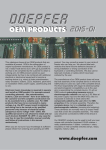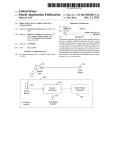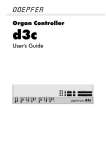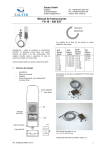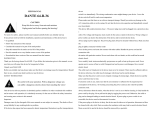Download DOEPFER LMK2+ User`s guide
Transcript
DOEPFER MIDI Keyboard PK88 User's Guide Contents 1. Introduction 2. Operating and Security Instructions 3. Power Supply 4. MIDI Connectors 5. Connection of the Foot Switch Appendix A: Modifications A-1: Foot switch type A-2: MIDI Channel Appendix B: Pin Assignment of the Jack Sockets 1. Introduction PK88 is a MIDI master keyboard designed especially for the requirements of the "mobile pianist" who needs a high class and easy to carry keyboard but is able to dispense with extended MIDI features. PK88 includes no sound generation as is was made to combine it with a piano expander offered by some manufaturers (e.g. Kurzweil, Emu, Yamaha, Roland, Akai). The PK88 uses a 88 keys keyboard with real hammer mechanics. The case used is a rugged and easy to carry black flightcase with handle and removable lid. The dimensions are about 135 x 27 x 11 cm, the weight is about 20 kg. The MIDI features are limited to what the user of such a keyboard really needs: PK88 transmits MIDI note events in the MIDI note range 21-108 with velocity on MIDI channel 1. The velocity resolution is 127 steps. We set a high value on the conversion of the mechanical impact to the MIDI velocity so that it is as close as possible to the bevaviour of a real piano - within the limited possibilities of MIDI. At the rear panel a double foot switch can be connected to obtain the piano features sustain (MIDI controller #64) and soft pedal (MIDI controller #67). If you need more MIDI functions - like pitch-bend, modulation, after touch, program change, start/stop/continue, keyboard-zones or others - we recommend one of our large-scale master keybords (e.g. LMK2+ or LMK4+). The PK88 is also available as bundle together with the Kurzweil Micro Piano. 2. Operating and Security Instructions Please follow the given instructions for use of the instrument because this will guarantee correct instrument operation. Due to the fact that these instructions touch on Product Liability, it is absolutely imperative that they be read carefully. Any claim for defect will be rejected if one or more of the items was observed. Disregard of the instructions can endanger the 6 month warranty. • The instrument may only be used for the purpose described in this operating manual. Due to safety reasons, the instrument must never be used for other purposes not described in this manual. If you are not sure about the intended purpose of the instrument please contact an expert. • The case (flight case) is not a packing suitable for shipment but the case of the instrument. If you want to ship the instrument via mail, UPS, rail, forwarding agency or others you always must use the original packaging. Therefore, you should keep the original packaging. • Transport the instrument carefully, never let it fall or overturn. Make sure that during transport and in use the instrument has a proper stand and does not fall, slip or turn over because persons could be injured. • The instrument or the external power supply may only be operated with the voltage written on the instrument power supply input on the rear panel or on the external power supply. • Before opening the instrument or the external power the instrument or external power supply must be disconnected from mains power supply. • All eventual modifications must only be carried out by a qualified person who will follow the valid safety instructions. Every modification should becarried out only at the manufacturer or an authorized service company. Any modification not released by the manufacturer leads to the extinction of the operation permission. • With the introduction of a third person the warranty will be lost. In case of a destroyed warranty seal, any warranty claim will be rejected. • The instrument must never be operated outdoors but in dry, closed rooms. Never use the instrument in a humid or wet environment nor near inflammables. • No liquids or conducting materials must get into the instrument. If this should happen the instrument must be disconnected from power immediately and be examined, cleaned and eventually be repaired by a qualified person. • Never subject the instrument to temperatures above +50°C or below -10°C. Before operation the instrument should have a temperature of at least 10°C. Do not place the instrument into direct sun light. Do not install the instrument near heat sources. • Keep the top side of the instrument free in order to guarantee proper ventilation, otherwise the instrument could be overheated. • All cables connected with the instrument must be checked periodically. If there is any damage the cables must be repaired or replaced by an authorized person. • Never place heavy objects on the instrument. PK88 User's Guide V2 - Page 2 • Never use the instrument in the immediate proximity of interfering electronic devices (e.g. monitors, power supplies, computers) since this could create disturbances within the instrument. • The exchange of electronic parts (e.g. EPROMs for software update) is allowed only if the instrument is disconnected from power supply. • The instrument should only be shipped in the original packaging. Any instruments shipped to us for return, exchange, warranty repair, update or examination must be in their original packaging! Any other deliveries will be rejected. Therefore, you should keep the original packaging and the technical documentation. • When using the instrument in Germany, the appropriate VDE standards must be followed. The following standards are of special importance: DIN VDE 0100 (Teil 300/11.85, Teil 410/11.83, Teil 481/10.87), DIN VDE 0532 (Teil 1/03.82), DIN VDE 0550 (Teil 1/12.69), DIN VDE 0551 (05.72), DIN VDE 0551e (06.75), DIN VDE 0700 (Teil 1/02.81, Teil 207/10.82), DIN VDE 0711 (Teil 500/10.89), DIN VDE 0860 (05.89), DIN VDE 0869 (01.85). VDE papers can be obtained from the VDE-Verlag GmbH, Berlin. 3. Power Supply The PK88 does not have a built-in power supply. Instead it uses a plug-in type external power supply (DC adapter). The connector is labeled „9V DC„ and is located next to the two MIDI sockets. The primary reason for this feature is the fact that line voltages and plug types vary considerably from country to country. Using a plug-in external supply the PK88 can be used anywhere with a locally purchased power supply, thus keeping the retail price down.The PK88 is switched ON by plugging the AC adapter into a wall outlet and connecting it to the appropriate jack on the back of the case. There is no separate ON/OFF switch. PK88 sold in Germany do include an AC adapter for 230V mains supply. In other countries the power supply is NOT included with the PK88 and must be purchased locally by the user. The power supply must be able to deliver a voltage of 7-12 VDC (unstabilized), as well as a minimum current of 100mA. 4. MIDI Connectors Next to the power supply connector you will find the two MIDI connectors labelled "MIDI-Out". On both connectors the same MIDI data are available. Connect one of both outputs with MIDI-IN of the device to be controlled (Expander, Synthesizer, Sampler) via a suitable MIDI-cable. If you want to control a second device with the same MIDI data you may use the second MIDI output or you link the devices via MIDI THRU/MIDI IN. 5. Connection of the Foot Switch Located on the rear of the keyboard case is a jack for connecting a single or double foot switch. Do not connect the footswitch unless the PK88 is switched OFF. The two foot switches have SUSTAIN (MIDI controller #64) and SOFT PEDAL function (MIDI controller #67). If a single foot switch is used only the SUSTAIN function is available. A suitable double foot switch is e.g. the DOEPFER VFP2. There are two types of foot switches available: "contacts open at rest" or "contacts closed at rest". The factory setting of the PK88 is for "closed at rest" (suitable for our VFP2). If you want to use a single or double foot switch "open at rest" you have to modify the setting for the foot switch type (see appendix: modifications). Please pay attention that some MIDI expanders do not support the MIDI controller #67 (Soft pedal). Sustain (#64) is recognized by nearly all expanders. Please refer to the user's guide of the expander used if both controllers are supported. The double foot switch is not included with the PK88 and has to be ordered separately if required. The PK88 will work without the double foot switch, although the functions SUSTAIN and SOFT PEDAL will not be available to the user in that case. PK88 User's Guide V2 - Page 3 Appendix A: Modifications These remarks are only for authorized service personal. If you open the device (removing the keyboard or the rear panel) the warranty will be lost. In case of a destroyed warranty seal, any warranty claim will be rejected. Every modification has to be carried out only at the manufacturer or an authorized service company. Any modification not released by the manufacturer leads to the extinction of the operation permission. For details you may ask for the PK88 service manual available at 10.- US$ (only in German language). 1. Foot switch type On the connector board behind the rear panel there is a jumper that defines the type of foot switch used in combination with the PK88. Two types of foot switches available: • "contacts open at rest": this means that the contact(s) inside the foot switch are open at rest and will close when the foot switch is actuated. In this case the jumper has to be open (i.e. removed or put to only one of the two pins) • "contacts closed at rest": this means that the contact(s) inside the foot switch are closed at rest and will open when the foot switch is actuated. In this case the jumper is has to be put on the 2-pin connector on the pc board. This is the factory setting (e.g. for VFP2). If the behaviour of the foot switch used with the PK88 is reverse the foot switch type setting has to be changed. To get at the jumper the rear panel has to be removed (4 screws). The connector board is fixed to the rear panel. The jumper is a small black or red plastic part located to the 10-pin connector leading to the keyboard. Remark: For all PK88 devices manufactured until end of 1999 the jumper had a different meaning (piano mode on/off). If you are not able to change the foot switch type with the jumper as described above you probably own a PK88 manufactured in 1999 or earlier. In this case the former user manual (without V2) is valid ! 2. MIDI channel On the scanner board below the keyboard there are 4 solder bridges (J5...J8) to adjust the MIDI channel. With these jumpers any MIDI channel between 1 and 16 can be selected. For this the keyboard has to be dismounted and the jumpers in question have to be set with solder wire. If J5...J8 are left open MIDI channel 1 is selected. If J5...J8 are closed the MIDI channel is 16. For details you may ask for the PK88 service manual available at 10.- US$. The factory setting is MIDI channel 1 (J5...J8 left open). Appendix B: Pin Assignment of the Jack Sockets 1 2 Foot Switch 2 (Soft Pedal) Foot Switch 1 (Sustain) Foot Controller 1 = +7...12V DC 2 = GND Power Supply PK88 User's Guide V2 - Page 4




